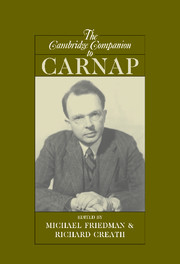Book contents
- Frontmatter
- Introduction: Carnap’s revolution in philosophy
- 1 Carnap’s intellectual development
- 2 Geometrical leitmotifs in Carnap’s early philosophy
- 3 Carnap and Frege
- 4 Carnap and Husserl
- 5 Carnap, Russell, and the external world
- 6 The Aufbau and the rejection of metaphysics
- 7 Carnap and the Vienna Circle: rational reconstructionism refined
- 8 Carnap and modern logic
- 9 Tolerance and logicism: logical syntax and the philosophy of mathematics
- 10 Carnap’s quest for analyticity: the Studies in Semantics
- 11 Carnap on the rational reconstruction of scientific theories
- 12 Carnap on probability and induction
- 13 Carnapian pragmatism
- 14 Quine’s challenge to Carnap
- Bibliography
- Index
2 - Geometrical leitmotifs in Carnap’s early philosophy
Published online by Cambridge University Press: 28 April 2008
- Frontmatter
- Introduction: Carnap’s revolution in philosophy
- 1 Carnap’s intellectual development
- 2 Geometrical leitmotifs in Carnap’s early philosophy
- 3 Carnap and Frege
- 4 Carnap and Husserl
- 5 Carnap, Russell, and the external world
- 6 The Aufbau and the rejection of metaphysics
- 7 Carnap and the Vienna Circle: rational reconstructionism refined
- 8 Carnap and modern logic
- 9 Tolerance and logicism: logical syntax and the philosophy of mathematics
- 10 Carnap’s quest for analyticity: the Studies in Semantics
- 11 Carnap on the rational reconstruction of scientific theories
- 12 Carnap on probability and induction
- 13 Carnapian pragmatism
- 14 Quine’s challenge to Carnap
- Bibliography
- Index
Summary
INTRODUCTION
Carnap was a leading figure of logical empiricism, but he did not begin as a logical empiricist. Hence, it is natural to ask how he became one. This question not only concerns the individual career of a distinguished philosopher, it is significant also for the wider question of how logical empiricism emerged in the general context of European philosophy in the early twentieth century.
Arguably, Carnap began his philosophical career as a neo-Kantian (cf. Coffa, 1991). But, as can be gleaned from his early writings, he was also influenced by scientists and philosophers such as Poincaré, Frege, Hilbert, Russell, Husserl, and Dingler, who did not belong to the Kantian tradition in the strict sense. Presently, the question of who influenced Carnap how is vigorously disputed among Carnap scholars (cf. Pincock, 2002). The aim of this chapter is not to take issue in this debate presenting a new candidate or offering new arguments in favor of one who is already in the race. Rather, I would like to concentrate on an influential factor of a different kind, namely, the influence philosophy of geometry had on Carnap’s philosophy. It is not difficult gathering evidence that philosophy of geometry was important for the early Carnap: his very first work, “Der Raum. Ein Beitrag zur Wissenschaftslehre” (1922), was a treatise on philosophy of geometry.
- Type
- Chapter
- Information
- The Cambridge Companion to Carnap , pp. 43 - 64Publisher: Cambridge University PressPrint publication year: 2007
- 5
- Cited by



